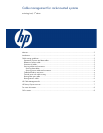
Cable routing guidelines
To minimize maintenance, safety, and performance issues, routing of power and data cables should
be in accordance with the following guidelines.
Separation of power and data cables
Cables in close proximity to each other, especially those oriented in parallel or in loops, can create
electromagnetic interference (EMI) through induction. EMI can result in erratic or error-prone data
transfers. To minimize the effects of EMI, power cables should be segregated from data cables as
much as possible:
• Dress all signal cables on the left side of the rack and all power cables on the right side of the rack.
• Arrange and secure excess power and data cabling separately.
• Use HP cable management kits described later in this paper to facilitate the segregation.
Retention of excess cable
Installing a number of components in a rack typically results in the use of some cables that are longer
than necessary. This is especially true when similar or redundant components with the same cable
types are installed at various levels in a rack. The excess cable lengths are often hurriedly bundled
and tied, resulting in problems associated with EMI or in damaged cables.
Here are some preferred methods of handling excess cables:
• Run and attach excess cables for easy, safe maintenance activities and proper operations.
• Ensure that secured cables are not pinched, damaged, or kinked (refer to the “
Cable bend radius
restrictions” section of this paper).
• When possible, use all cable management arms included in component kits.
• Use HP cable management kits described later in this paper for maintaining and managing cables.
Protection of cables
Cables must be protected at points where they might rub or come in contact with sharp edges or
heated areas. Extra care must be used with power cables because damaged conductors could cause
downtime and because exposed conductors are a safety hazard.
To protect cables, HP recommends the following practices:
• Avoid dressing cables tightly over sharp edges of railing or panels.
• Avoid pinching of cables between components or mounting/sliding rails.
• Protect the cables if they may be pinched or damaged.
Securing cables and connectors
Cables and connectors should be secured to prevent excessive movement and to provide strain relief
at critical points.
Securing data cables
For securing data cables, HP recommends the following practices:
• Ensure that cable connections are not stressed from any cable or chassis movement.
• Dress cables on management arms securely enough to prevent interference with movement or
pinched cables, yet not so tight as to cause binding to the arm.
3










